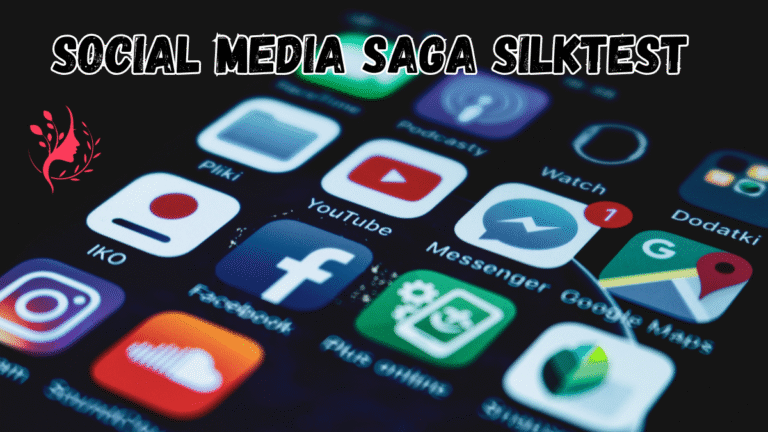In an era where digital evolution is ceaseless and content is omnipresent, new paradigms are constantly reshaping how individuals, companies, and even algorithms interpret online interactions. One such intriguing phenomenon is the social media saga silktest — a digital narrative thread that has recently drawn attention among digital marketers, automation testers, content creators, and social observers alike.
Unlike typical buzzwords that flare up briefly and disappear, this phrase represents a multifaceted story involving automation, social storytelling, content validation, and digital identity testing. This article delves into the unique tale behind the social media saga silktest, interpreting it through technical, cultural, psychological, and narrative lenses.
Understanding the Context: What Is the Social Media Saga SilkTest?
To dissect this concept, we must break it down.
- “Social Media Saga”: Refers to an evolving, often dramatic narrative or event that unfolds on or because of social media platforms.
- “SilkTest”: Traditionally known as a software testing tool, SilkTest is used for automated functional and regression testing. But in this new context, it morphs into a metaphor or even a literal framework used to evaluate the credibility, durability, and logic of stories on social media.
So, “social media saga silktest” is more than a trending phrase — it’s a new way of understanding and interrogating narratives online using methods of automation, verification, and critical assessment.
The Origin of the Social Media Saga SilkTest Phenomenon
The phrase began surfacing in niche communities online—particularly within circles involved in digital QA (quality assurance), media verification, and meme warfare. As misinformation campaigns became more sophisticated, tech communities began discussing frameworks that could serve as a kind of “SilkTest” for social media sagas.
The analogy is compelling: just as SilkTest validates the behavior of web applications against expected outcomes, could we validate a social media saga—a viral story or trend—against reality, intention, or digital integrity?
Components of a Modern Social Media Saga
Every social media saga includes the following foundational elements:

1. Origin Point
This is where the saga begins: a tweet, video, TikTok, blog post, or Reddit thread. It’s often sensational, mysterious, or humorous enough to ignite shares, retweets, and screenshots.
2. Amplification Cycle
Algorithms play their part, boosting content based on engagement metrics. Influencers may unwittingly or strategically amplify the narrative.
3. Polarization Moment
Discussions become divisive. Audiences take sides. Hashtags emerge. Misinformation might creep in.
4. Verification War
Fact-checkers, sleuths, and digital detectives enter the scene. Screenshots are debunked. Timelines are dissected.
5. Narrative Collapse or Evolution
The saga either collapses under the weight of facts, gets memory-holed, or morphs into a long-term meme, movement, or cautionary tale.
This is where the social media saga silktest comes in—as a mechanism to examine how a saga develops, what truths it contains, and what digital tests it can pass.
Applying SilkTest Logic to a Social Media Saga
If we consider the literal SilkTest framework, its structure involves:
- Object recognition
- State validation
- Scenario simulation
- Error logging
- Automation of repetitive tests
Translating this to a digital narrative gives us a unique toolkit:
- Object Recognition → Identifying the original media and actors involved.
- State Validation → Cross-checking dates, data, locations, and claims.
- Scenario Simulation → Predicting how various audiences interpret the content.
- Error Logging → Documenting inconsistencies or manipulations.
- Automation → Creating systems or bots that flag dubious content patterns.
The social media saga silktest thus represents a hybrid between human insight and automated logic—a bridge between QA practices and narrative truth-seeking.
The Psychological Pull of Social Media Sagas
To understand why this concept has gained traction, we need to look at the psychology of storytelling and virality.

The Dopamine Loop
Platforms are engineered to reward engagement. Every like, comment, and share is part of a feedback loop that encourages further interaction. Sagas create high-stakes drama that keeps users hooked.
Tribal Identity
Taking sides in a social saga gives users a sense of belonging. They feel part of something larger, reinforcing their online identity and moral positioning.
The Need for Coherence
Humans crave resolution. When sagas lack clear endings, they linger in our minds. The social media saga silktest offers a form of closure—a logical framework to analyze what was real and what was performative.
Case Studies: The Social Media Saga SilkTest in Action
Let’s explore a few sagas that could’ve benefited from (or were analyzed using) a social media saga silktest methodology.
1. The AI-Generated Pope in a Puffer Jacket
A hyper-realistic image of Pope Francis in a white Balenciaga puffer coat went viral, with many believing it was real. The saga unfolded over a weekend, with millions fooled. It took professional image analysts and open-source verification to trace it back to MidJourney.
- SilkTest Application: Object recognition flagged unusual lighting inconsistencies. Reverse image search failed. Eventually, a scenario simulation showed that audiences trusted authoritative-looking fashion, even when absurd.
2. The “Instagram Therapy” Backlash
A viral thread on X (formerly Twitter) criticized a wave of “therapy speak” memes. What began as critique turned into a saga about generational psychology, privilege, and misinformation. Articles were written, videos made, even therapists chimed in.
- SilkTest Application: Error logging showed recycled content. Timeline validation exposed tweets taken out of context. Verification logic debunked several “quotes” as fabricated.
The Role of Automation and AI in the SilkTest Process
One exciting aspect of the social media saga silktest concept is the integration of AI tools and automation to examine the flow of information.

Pattern Recognition Algorithms
Machine learning models can detect emotional tone shifts in comments and responses. This data can help forecast when a saga is nearing a tipping point.
Bot and Troll Detection
Using natural language processing (NLP), automated systems can identify non-human behavior in the engagement cycle—like coordinated retweeting or comment farming.
Fake Media Detection
Deepfake detection models and media forensics are crucial in applying the SilkTest metaphor to visual content. AI can scan image inconsistencies invisible to the human eye.
Ethical and Cultural Implications
The social media saga silktest is not just a technological or narrative tool—it has ethical weight.
Who Gets to Test the Story?
Verification requires gatekeepers, but who decides what’s worth verifying? Decentralized testing methods are emerging, but trust remains a critical issue.
Cultural Bias in Verification
Automated systems may misinterpret content from non-Western cultures due to limited training data, leading to false negatives or positives.
Story Ownership and Reclamation
Sometimes, sagas are co-opted. An authentic cultural moment can become a meme stripped of context. The SilkTest logic helps trace original intent and restore narrative agency.
Future of the Social Media Saga SilkTest: From Idea to Industry
What began as a metaphor is fast becoming a methodology. Here’s how the social media saga silktest might evolve:
- Content Authenticity Certifications: Creators might seek badges or seals proving their saga passed a SilkTest evaluation.
- API Integrations for Platforms: Social platforms could integrate SilkTest-like tools to alert users about manipulated content or unreliable stories.
- Educational Use: Media literacy programs could use the social media saga silktest framework to teach students how to dissect viral narratives critically.
Final Thoughts: Toward a More Verified Digital Future
The social media saga silktest isn’t just a clever portmanteau—it’s a call for responsibility, curiosity, and rigor in an age of viral storytelling. By borrowing from automation testing, we gain not only tools but a mindset: one that values verification over virality, truth over trends, and logic over likes.
In a digital world overflowing with content, applying a SilkTest approach to social media sagas could be the key to reclaiming coherence, credibility, and community trust.
For more information visite the website

